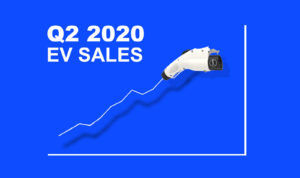A steep, across-the-board drop in auto sales hit zero-emission vehicles even harder than gas-powered transport, but ZEV market share still rose in first half of 2020 compared to the same period in 2019

A steep, across-the-board drop in auto sales hit zero-emission vehicles even harder than gas-powered transport, but ZEV market share still rose in first half of 2020 compared to the same period in 2019
Zero-emission vehicle (ZEV) sales in Canada saw a marked decline in the second quarter of 2020, with only 9,069 sold between April and June, according to sales figures provided by Electric Mobility Canada (EMC) to Electric Autonomy. That number includes battery electric vehicles as well as plug-in hybrids and hydrogen fuel cell vehicles.
The results represent a drop of over 50 per cent from the 18,032 sold in the same period in 2019. EVs’ overall light vehicle market share in Q2 also dropped to 2.9 per cent from the 3.4 per cent they held for the same period in 2019.
Sales of new vehicles on the whole were down 45 per cent in the second quarter and 34 per cent in the first half of 2020, due to the widespread economic shutdowns in effect throughout most of Canada since mid-March.
Some positives
There is at least one bright spot: across the first half of 2020, ZEVs held a market share of 3.3 per cent, which still represents a rise from the 2.7 per cent seen in the first half of 2019.
Q2’s numbers disappoint especially when compared with the more hopeful figures seen in the quarter preceding it. From January through March, 11,998 ZEVs were sold in Canada, representing roughly 3.8 per cent of the country’s total light vehicle market share. Additionally, roughly 5.6 per cent of new light vehicles sold in March were ZEVs, a record for monthly ZEV market share in Canada.
Nevertheless, the total amount of ZEVs on Canada’s roads still continues to climb. According to EMC, that number now sits at approximately 168,000, with 75,000 of those located in Quebec, 46,000 in Ontario, and 41,000 in British Columbia.
By far the best-selling battery electric vehicle across Canada in the first half of 2020 was Tesla’s Model 3, with 6,826 sold. Following in its lead were the Chevrolet Bolt, with 1,618 sold, and the Hyundai Kona, with 1,155 sold.
“A very strange year”
The unprecedented effect that COVID-19 has had on vehicle supply chains and sales makes it difficult to forecast what the next year in ZEVs may look like.
“Honestly, I think that the stats are to be taken up to a point with a grain of salt… it’s a very strange year,” says Daniel Breton, CEO of Electric Mobility Canada. “Many provinces have told customers and buyers because of the year, they did not necessarily have to register the car right away.”
“Manufacturers have had to stop production of vehicles altogether, which has affected inventory, and electric vehicle supply was more limited to start with,” notes Breton. “The sales have gone down for gas vehicles as well as electric vehicles.
“We cannot base any projection on what’s happened in Q2, because it’s really bizarre. Before we can make any statement, we should see the whole year’s figures.”
Another reason for the stark drop in market share from Q2 2019 was the launch of the federal government’s rebate program in that quarter, which Breton suggests triggered a buying surge as many drivers had been waiting to purchase EVs.
“[The federal rebate] increased sales greatly in May and June. After June, the inventory dropped quickly and in the fall there were not as many sales.”
Despite the drop in vehicle sales, new data shows that existing electric vehicle drivers are getting back on the roads across Canada, with charging networks run by BC Hydro and Hydro Québec each reporting public charging numbers nearly as high as those seen in February, before COVID-19 hit.






